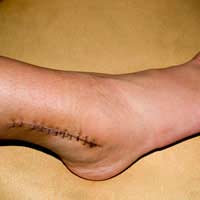Scarring After Surgery

Scarring after surgery is the body’s way of healing itself and will occur when the top layer of skin is damaged. The more serious the damage to the skin, the more severe the scarring will be. After invasive surgery, such as cosmetic and plastic surgery, or after surgical operations such as heart operations, there will be a degree of scarring to the skin. Scars will never completely be eliminated, however, there are a number of ways to make them seem less visible.
How Scars Occur
Scars are comprised of fibrous tissue; when the skin is damaged this tissue will form over the wound to repair the cut. Scar tissue is different from the actual skin that it covers, hair and sweat glands will not form on the scar and the scar tissue is not as resistant to ultra violet radiation. When the scars are exposed to the sun they will tan easily and become more visible.Factors that Determine Degrees of Scarring
In terms of how much you will scar there are a few factors that need to be taken into account. A lot of the factors will come down to age, lifestyle and genetics, and the part of the body where the scarring occurs. Scars to younger people will be more visible as the scar tends to heal more robustly, with older people scars will not be as visible. With genetics the severity of the scar simply comes down to your DNA, skin type and skin tone. If you are a smoker or are a sun worshipper then your scar will also be more visible.In terms of scarring after surgery then scars will be less visible if the operation has been on a part of the body with loose skin. Breast surgery will leave less scarring than an operation to parts of the body where the skin is thin. You should also follow your surgeon’s strict orders on the best ways to help scarring heal after a surgery. If the surgeon has told you to wear protective padding for so many weeks after surgery, then this should be followed to the letter.
Scarring Treatments
There are procedures that can be used to minimise scarring after surgery or to help subdue scars that have occurred naturally or through injury, this is sometimes known as scar revision. If a surgeon feels that the scar can be treated then the procedure will be performed under local anaesthesia and any stitches used will be removed within six to ten days, the earlier the better if the scar revision is to the face.Common Types of Scar Revision
- Burn Scars
- Acne scars
- Keloids – thick scars that grow around the edges of wounds
Wound Healing after Surgery
Your surgeon will no doubt have given you some information on the type and severity of scarring that will occur with your intended surgery. No matter what type of operation your surgeon will try his or her best to minimise any scarring.This will include placing stitches below the surface of the skin, holding the wound in place and taking any stress from the edges of the skin. The edges of the operated skin should always be touching naturally before the final stitches are in place. There is more chance of scarring occurring if tension below the skin pulls the edges apart.


Re: Heart Surgery
My dad needs a stent. How can i find a private clinic in costa blanka spain. ?
Re: Getting an MRI Scan Abroad
Zoe - Your Question:Cost of mri of neck and entire back abroad., france?Our Response:I'm afraid
Re: Getting an MRI Scan Abroad
Cost of mri of neck and entire back abroad., france?
Re: Medical Treatments in Belgium
I had an accident at 7/6/2012 caused fracture C5&C6 and quadriplegia, However currently I improved well but I have some problems…
Re: Heart Surgery
how can i find cost of abalition for afib one good day 4 bad cycle
Re: Costs of Treatments
Boots2341 - Your Question:Hi,I have several health concerns and my GP is not interested.2( Change in bowel movement, occasional bouts of blood…
Re: Costs of Treatments
Hi, I have several health concerns and my GP is not interested. 2( Change in bowel movement, occasional bouts of blood in the and a sharp…
Re: Heart Surgery
KL1 - Your Question:I am advised that I need a double heart bypass. What are the best hospitals to have this done in Malaysia?
Re: Heart Surgery
I am advised that I need a double heart bypass. What are the best hospitals to have this done in Malaysia?
Re: Medical Insurance for Your Treatment Abroad
I`m going for breast reconstruction cant find any insurance